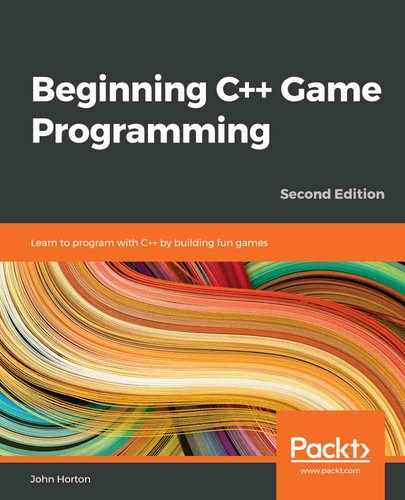Chapter 23: Before You Go...
When you first opened this big doorstop of a book, the back page probably seemed like a long way off. But it wasn't too tough, I hope.
The point is you are here now and, hopefully, you have a good insight into how to build games using C++.
The point of this chapter is to congratulate you on a fine achievement but also to point out that this page probably shouldn't be the end of your journey. If, like me, you get a bit of a buzz whenever you make a new game feature come to life, then you probably want to learn more.
It might surprise you to hear that, even after all these hundreds of pages, we have only dipped our toes into C++. Even the topics we did cover could be covered in more depth and there are numerous – some quite significant – topics that we haven't even mentioned. With this in mind, let's take a look at what might be next.
If you absolutely must have a formal qualification, then the only way to proceed is with a formal education. This, of course, is expensive and time-consuming, and I can't really help any further.
On the other hand, if you want to learn on the job, perhaps while starting work on a game you will eventually release, then what follows is a discussion of what you might like to do next.
Possibly the toughest decision we face with each project is how to structure our code. In my opinion, the absolute best source of information on how to structure your C++ game code is http://gameprogrammingpatterns.com/. Some of the discussion is around concepts that aren't covered in this book, but much of it will be completely accessible. If you understand classes, encapsulation, pure virtual functions, and singletons, dive into this website.
I have already pointed out the SFML website throughout this book. In case you haven't visited it yet, please take a look at it: http://www.sfml-dev.org/.
When you come across C++ topics you don't understand (or have never even heard of), the most concise and organized C++ tutorials can be found at http://www.cplusplus.com/doc/tutorial/.
In addition to this, there are four more SFML books you might like to look into. They are all good books but vary greatly in who they are suitable for. Here is a list of the books in ascending order from most beginner focused to most technical:
- SFML Essentials by Milcho G. Milchev: https://www.packtpub.com/game-development/sfml-essentials
- SFML Blueprints by Maxime Barbier: https://www.packtpub.com/game-development/sfml-blueprints
- SFML Game Development By Example by Raimondas Pupius: https://www.packtpub.com/game-development/sfml-game-development-example
- SFML Game Development by Jan Haller, Henrik Vogelius Hansson, and Artur Moreira: https://www.packtpub.com/game-development/sfml-game-development
You also might like to consider adding life-like 2D physics to your game. SFML works perfectly with the Box2d physics engine. This URL is for the official website: http://box2d.org/. The following URL takes you to probably the best guide to using it with C++: http://www.iforce2d.net/.
Lastly, I am going to shamelessly plug my own website for beginner game programmers: http://gamecodeschool.com.
Thanks!
Most importantly, thanks very much for buying this book and keep making games!
